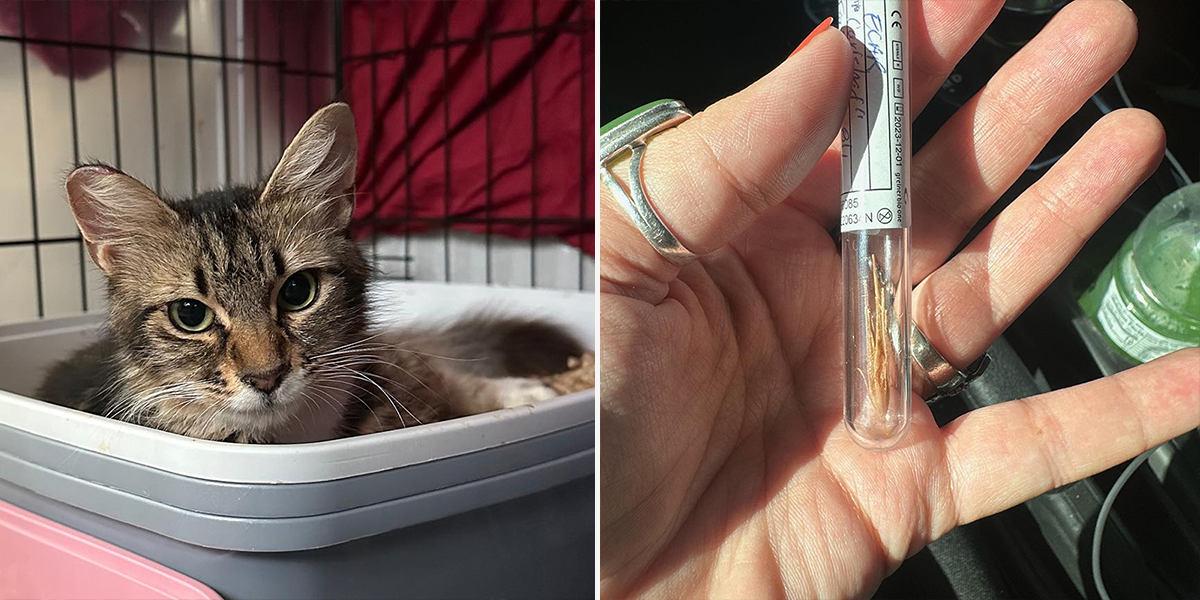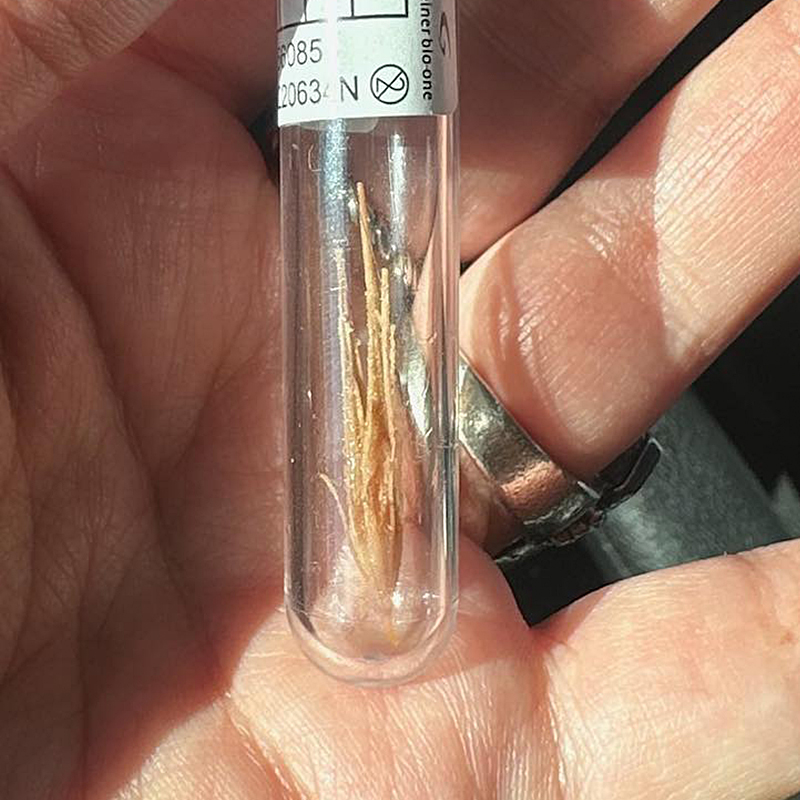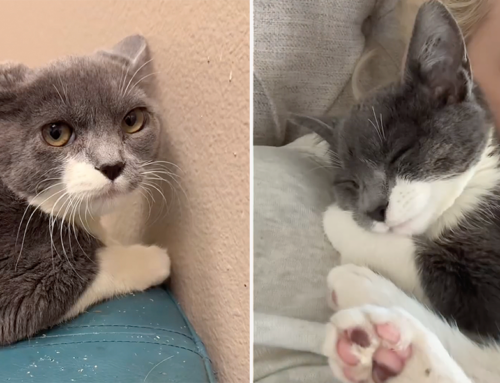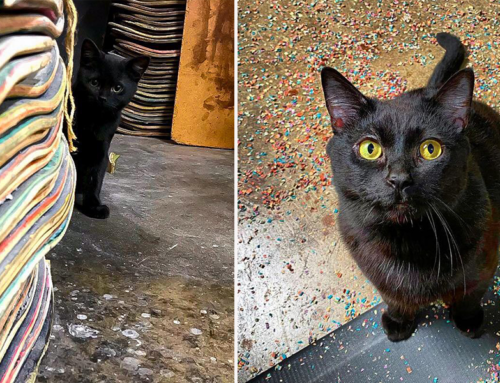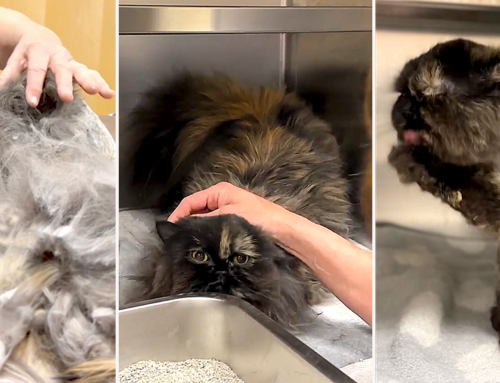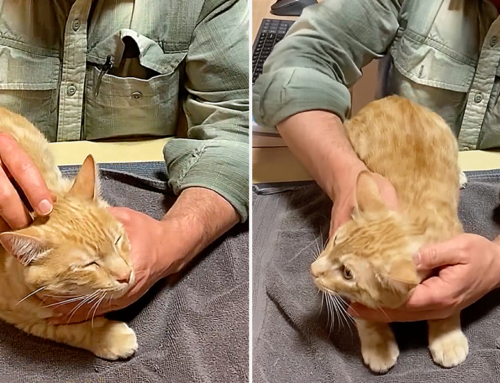Depending on where you live, the great outdoors pose a million hazards for house cats, but here’s something you don’t hear every day: Common outdoor foxtails can lead to injuries that can, on rare occasions, be deadly for cats or dogs. Although we don’t want to cause unnecessary worry, it’s something to be aware of.
Foxtail grass plumes are pretty in the summer with fluffy tufts that resemble a fox’s bushy tail. The invasive annual grass grows all year in western states. However, the various species are found throughout North America, including New England states.
Unfortunately, it’s hard to tell apart from edible Timothy grass. Instead, it has barbed seeds called “awns” that stick to animals, a serious problem for horses and other grazers. Those feathery spiked awns stick to a horse’s mouth and gums and scratch eyes. But surprisingly, they can even work into the skin and cause serious lesions and infections. Yep, an ordinary type of grass can do that.

Foxtail grass grows by a roadside via Wikimedia Commons
Foxtails Embed Deep Inside a Mama Cat
A rescue in San Diego, East County Animal Rescue (ECAR), shared a public service announcement when vets found a large foxtail spike had gotten into a cat’s bladder. The semi-feral mother cat was nursing kittens, but the foster mom noticed she was bleeding from behind. Shockingly, the foxtails embedded into the cat’s body and worked all the way into her bladder!

Mama cat with kittens at San Diego’s East County Animal Rescue (ECAR) via Facebook
Since unspayed cats often develop infections, the vet spayed her and treated her for a urinary infection. But after a month and a half, the mama wasn’t improving, peeing blood. It took a urinalysis, bloodwork, X-rays and ultrasound to discover the foxtails inside her bladder. After surgery, she recovered after what must have been months of pain. And to think that despite it all, she was still heroically doing her best for her little ones.
Notably, it was the first time the vet had seen a case exactly like this one, but the rescuers wanted to raise awareness. In all likelihood, the mama had probably been exposed by hiding in the grass to find cover for her babies.
“PLEASE check your pets daily for these pesky weeds and be sure to remove them immediately. Another reason why cats should remain indoors. As for the feral kitties living their lives outside. We just need to hope they are discovered before any true damage is done. They have such a hard life, so the best we can do for them is to TNR so no more are born into this outdoor life,” shared ECAR.
You can see more on East County Animal Rescue’s Instagram and Facebook.
Foxtail Seeds Burrow into Tissue
As the vet said, this was an unusual case, and one wonders what can be done to prevent it. After all, the barbed foxtails can stick to any part of a cat, dog, or other animal. Commonly, they’ll stick between toes or inside the ears, eyes, or mouth. In the case of the mama cat, it may have stuck to her genital area and worked into her body that way.
If they stick to the skin, they burrow in, push forward like a porcupine quill, and don’t break down inside the body. According to WebMD, a seed stuck inside the nose can reach the brain, or a seed on the body can eventually perforate a lung or any other part of the body.
If your cat is unusually licking, scratching, shaking, or having discharge from the nose, ears, or bloody urine, you would already know to see a vet immediately. Less obvious symptoms include the sudden onset of bad breath, lack of energy, or appetite.
If such symptoms happen, one might never guess a type of grass is the problem! So, if you live in an area where foxtails are around, it’s a good idea to mention that to your veterinarian. If they grow in your yard, you can mow them or pull them out before they grow the fluffy tufts. No need for polluting herbicides or chemicals that harm the environment.
Of course, keeping pets on a leash and out of the tall grass helps avoid the problem, as well as pesky ticks. As always, we encourage keeping house cats indoors or in an enclosed catio to keep them safe.
What to Do About Foxtails?
So, how can we protect pets from, of all things, foxtails? It’s common sense: In the summertime, keep an eye out and groom with a fine-tooth brush or comb frequently, looking over their entire body, including the mouth and gums and between those toe beans. Most with outdoor pets would already be doing that for ticks.
If your cat or dog has long hair, they will need more trimming than in the cool months. Animals with long or curly hair are more at risk. As you inspect the fur, you can remove the foxtails with tweezers. After removing them, use antibacterial soap and rinse the area with water. But if you see an embedded part, get to the vet ASAP. Otherwise, it can work itself further into the skin. Often, they’ll come out on their own but who knows where they could end up if they don’t.
Below, another kitten lost an eye to a foxtail at ECAR but fully recovered after surgery. Image via Facebook.


